FIAT ULYSSE 2008 2.G Owners Manual
Manufacturer: FIAT, Model Year: 2008, Model line: ULYSSE, Model: FIAT ULYSSE 2008 2.GPages: 254, PDF Size: 3.46 MB
Page 141 of 254
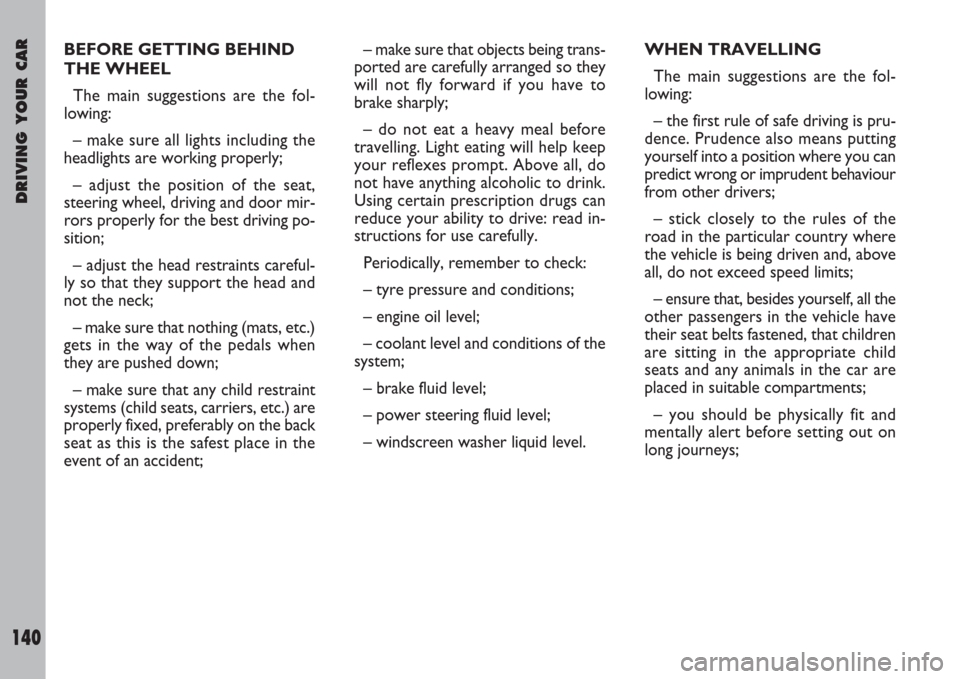
DRIVING YOUR CAR
140
BEFORE GETTING BEHIND
THE WHEEL
The main suggestions are the fol-
lowing:
– make sure all lights including the
headlights are working properly;
– adjust the position of the seat,
steering wheel, driving and door mir-
rors properly for the best driving po-
sition;
– adjust the head restraints careful-
ly so that they support the head and
not the neck;
– make sure that nothing (mats, etc.)
gets in the way of the pedals when
they are pushed down;
– make sure that any child restraint
systems (child seats, carriers, etc.) are
properly fixed, preferably on the back
seat as this is the safest place in the
event of an accident;– make sure that objects being trans-
ported are carefully arranged so they
will not fly forward if you have to
brake sharply;
– do not eat a heavy meal before
travelling. Light eating will help keep
your reflexes prompt. Above all, do
not have anything alcoholic to drink.
Using certain prescription drugs can
reduce your ability to drive: read in-
structions for use carefully.
Periodically, remember to check:
– tyre pressure and conditions;
– engine oil level;
– coolant level and conditions of the
system;
– brake fluid level;
– power steering fluid level;
– windscreen washer liquid level.WHEN TRAVELLING
The main suggestions are the fol-
lowing:
– the first rule of safe driving is pru-
dence. Prudence also means putting
yourself into a position where you can
predict wrong or imprudent behaviour
from other drivers;
– stick closely to the rules of the
road in the particular country where
the vehicle is being driven and, above
all, do not exceed speed limits;
– ensure that, besides yourself, all the
other passengers in the vehicle have
their seat belts fastened, that children
are sitting in the appropriate child
seats and any animals in the car are
placed in suitable compartments;
– you should be physically fit and
mentally alert before setting out on
long journeys;
Page 142 of 254
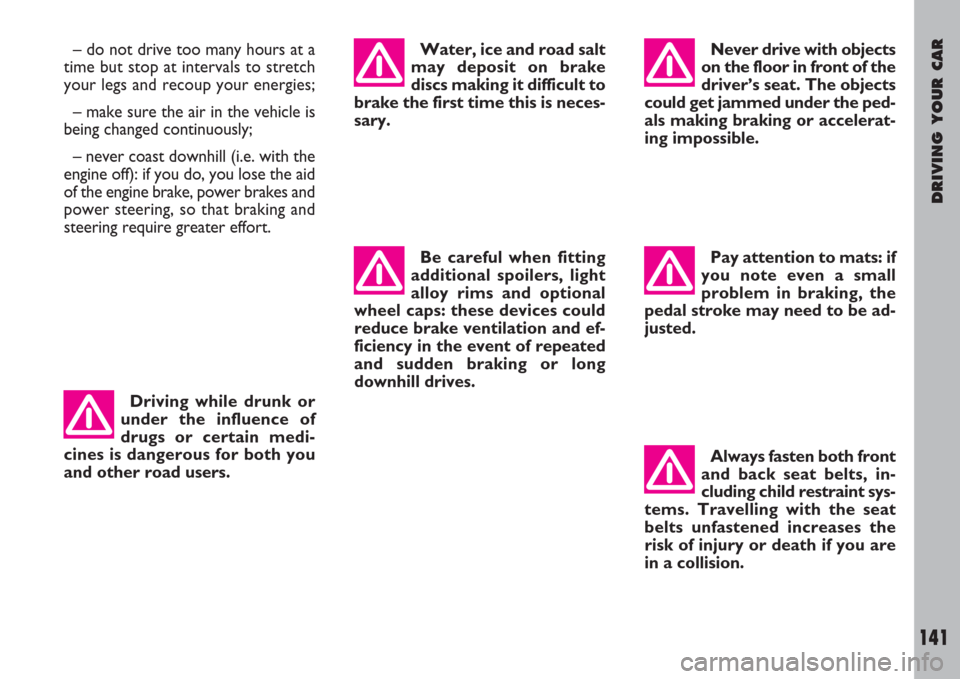
DRIVING YOUR CAR
141
Be careful when fitting
additional spoilers, light
alloy rims and optional
wheel caps: these devices could
reduce brake ventilation and ef-
ficiency in the event of repeated
and sudden braking or long
downhill drives.Never drive with objects
on the floor in front of the
driver’s seat. The objects
could get jammed under the ped-
als making braking or accelerat-
ing impossible.
Driving while drunk or
under the influence of
drugs or certain medi-
cines is dangerous for both you
and other road users.Pay attention to mats: if
you note even a small
problem in braking, the
pedal stroke may need to be ad-
justed.
Always fasten both front
and back seat belts, in-
cluding child restraint sys-
tems. Travelling with the seat
belts unfastened increases the
risk of injury or death if you are
in a collision.
Water, ice and road salt
may deposit on brake
discs making it difficult to
brake the first time this is neces-
sary.– do not drive too many hours at a
time but stop at intervals to stretch
your legs and recoup your energies;
– make sure the air in the vehicle is
being changed continuously;
– never coast downhill (i.e. with the
engine off): if you do, you lose the aid
of the engine brake, power brakes and
power steering, so that braking and
steering require greater effort.
Page 143 of 254
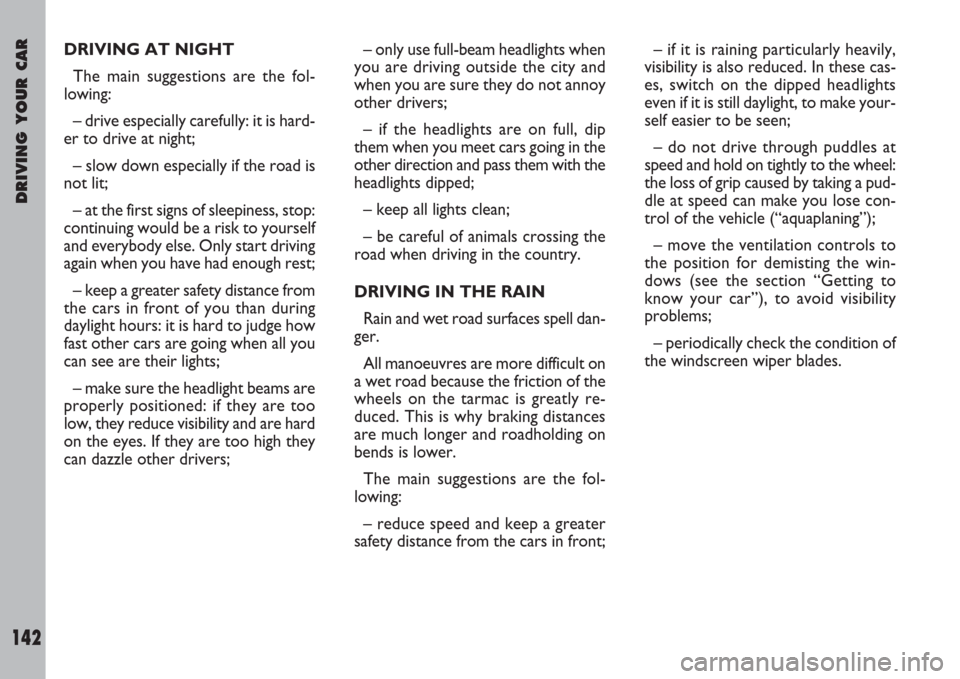
DRIVING YOUR CAR
142
– only use full-beam headlights when
you are driving outside the city and
when you are sure they do not annoy
other drivers;
– if the headlights are on full, dip
them when you meet cars going in the
other direction and pass them with the
headlights dipped;
– keep all lights clean;
– be careful of animals crossing the
road when driving in the country.
DRIVING IN THE RAIN
Rain and wet road surfaces spell dan-
ger.
All manoeuvres are more difficult on
a wet road because the friction of the
wheels on the tarmac is greatly re-
duced. This is why braking distances
are much longer and roadholding on
bends is lower.
The main suggestions are the fol-
lowing:
– reduce speed and keep a greater
safety distance from the cars in front;– if it is raining particularly heavily,
visibility is also reduced. In these cas-
es, switch on the dipped headlights
even if it is still daylight, to make your-
self easier to be seen;
– do not drive through puddles at
speed and hold on tightly to the wheel:
the loss of grip caused by taking a pud-
dle at speed can make you lose con-
trol of the vehicle (“aquaplaning”);
– move the ventilation controls to
the position for demisting the win-
dows (see the section “Getting to
know your car”), to avoid visibility
problems;
– periodically check the condition of
the windscreen wiper blades. DRIVING AT NIGHT
The main suggestions are the fol-
lowing:
– drive especially carefully: it is hard-
er to drive at night;
– slow down especially if the road is
not lit;
– at the first signs of sleepiness, stop:
continuing would be a risk to yourself
and everybody else. Only start driving
again when you have had enough rest;
– keep a greater safety distance from
the cars in front of you than during
daylight hours: it is hard to judge how
fast other cars are going when all you
can see are their lights;
– make sure the headlight beams are
properly positioned: if they are too
low, they reduce visibility and are hard
on the eyes. If they are too high they
can dazzle other drivers;
Page 144 of 254
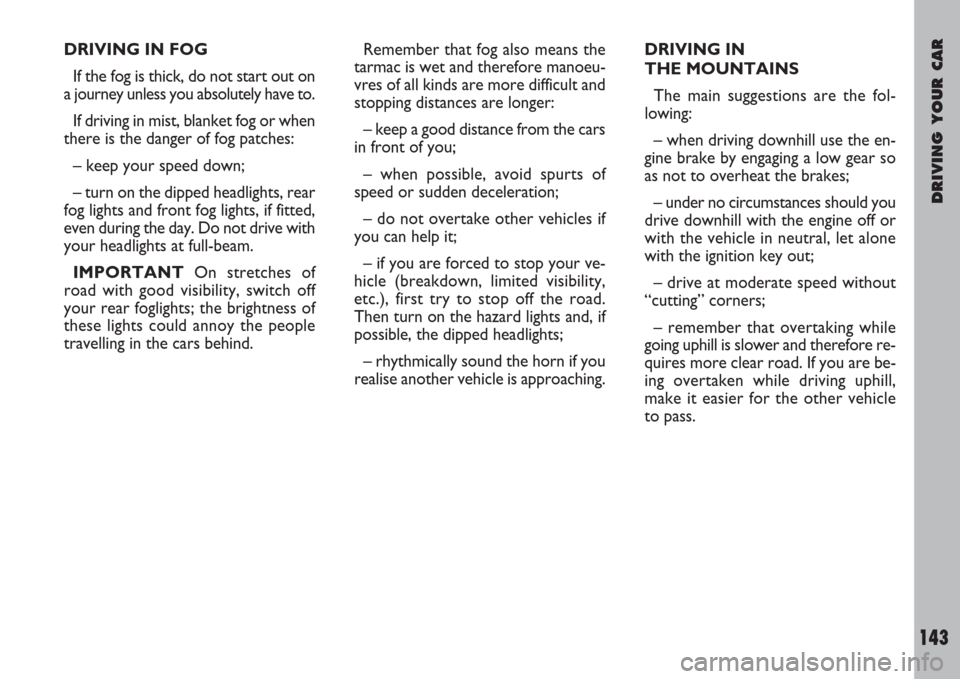
DRIVING YOUR CAR
143
Remember that fog also means the
tarmac is wet and therefore manoeu-
vres of all kinds are more difficult and
stopping distances are longer:
– keep a good distance from the cars
in front of you;
– when possible, avoid spurts of
speed or sudden deceleration;
– do not overtake other vehicles if
you can help it;
– if you are forced to stop your ve-
hicle (breakdown, limited visibility,
etc.), first try to stop off the road.
Then turn on the hazard lights and, if
possible, the dipped headlights;
– rhythmically sound the horn if you
realise another vehicle is approaching.DRIVING IN
THE MOUNTAINS
The main suggestions are the fol-
lowing:
– when driving downhill use the en-
gine brake by engaging a low gear so
as not to overheat the brakes;
– under no circumstances should you
drive downhill with the engine off or
with the vehicle in neutral, let alone
with the ignition key out;
– drive at moderate speed without
“cutting” corners;
– remember that overtaking while
going uphill is slower and therefore re-
quires more clear road. If you are be-
ing overtaken while driving uphill,
make it easier for the other vehicle
to pass. DRIVING IN FOG
If the fog is thick, do not start out on
a journey unless you absolutely have to.
If driving in mist, blanket fog or when
there is the danger of fog patches:
– keep your speed down;
– turn on the dipped headlights, rear
fog lights and front fog lights, if fitted,
even during the day. Do not drive with
your headlights at full-beam.
IMPORTANTOn stretches of
road with good visibility, switch off
your rear foglights; the brightness of
these lights could annoy the people
travelling in the cars behind.
Page 145 of 254
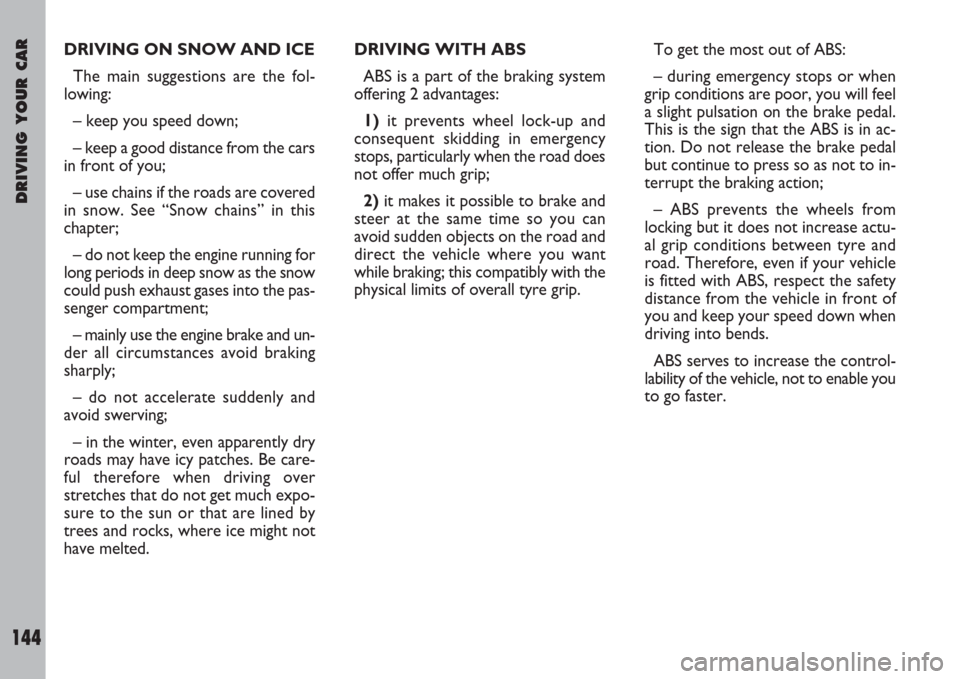
DRIVING YOUR CAR
144
DRIVING WITH ABS
ABS is a part of the braking system
offering 2 advantages:
1)it prevents wheel lock-up and
consequent skidding in emergency
stops, particularly when the road does
not offer much grip;
2)it makes it possible to brake and
steer at the same time so you can
avoid sudden objects on the road and
direct the vehicle where you want
while braking; this compatibly with the
physical limits of overall tyre grip.To get the most out of ABS:
– during emergency stops or when
grip conditions are poor, you will feel
a slight pulsation on the brake pedal.
This is the sign that the ABS is in ac-
tion. Do not release the brake pedal
but continue to press so as not to in-
terrupt the braking action;
– ABS prevents the wheels from
locking but it does not increase actu-
al grip conditions between tyre and
road. Therefore, even if your vehicle
is fitted with ABS, respect the safety
distance from the vehicle in front of
you and keep your speed down when
driving into bends.
ABS serves to increase the control-
lability of the vehicle, not to enable you
to go faster. DRIVING ON SNOW AND ICE
The main suggestions are the fol-
lowing:
– keep you speed down;
– keep a good distance from the cars
in front of you;
– use chains if the roads are covered
in snow. See “Snow chains” in this
chapter;
– do not keep the engine running for
long periods in deep snow as the snow
could push exhaust gases into the pas-
senger compartment;
– mainly use the engine brake and un-
der all circumstances avoid braking
sharply;
– do not accelerate suddenly and
avoid swerving;
– in the winter, even apparently dry
roads may have icy patches. Be care-
ful therefore when driving over
stretches that do not get much expo-
sure to the sun or that are lined by
trees and rocks, where ice might not
have melted.
Page 146 of 254

DRIVING YOUR CAR
145
CONTAINING RUNNING COSTS
AND POLLUTION
Tyres
Tyre pressure should be checked at
least once every four weeks: if the
pressure is too low fuel consumption
increases as the resistance to the
rolling movement of the tyre is
greater. In this state, tyre wear is in-
creased and vehicle handling suffers,
which will effect safety.
Unnecessary loads
Do not travel with too much luggage
stowed in the boot. The weight of the
vehicle (especially when driving in the
city) and its trim greatly effects con-
sumption and stability.
Roof rack/ski rack
Remove the roof/ski rack from the
roof when no longer necessary. These
accessories reduce the vehicle’s aero-
dynamic penetration, which affects
consumption. Use a trailer, if particu-
larly heavy objects are to be trans-
ported. Some suggestions which may help
you to keep the running costs of the
car down and lower the amount of
toxic emissions released into the at-
mosphere are given below.
GENERAL CONSIDERATIONS
Car maintenance
The overall state of the vehicle is an
important factor that has a marked in-
fluence over fuel consumption, driving
comfort and on the life span of your
vehicle. For this reason, care should
be taken to maintain your vehicle by
carrying out the necessary checks and
observing regulations in accordance
with the specifications given in the
Scheduled Maintenance Programme
(see section, idling, air cleaners, tim-
ing).Electrical devices
Use electric devices for the neces-
sary time only. The heated rear win-
dow, supplementary lights, windscreen
wipers, heating system blower require
large amounts of electricity; this means
an increase in the request for power
and consequently an increase in fuel
consumption (up to +25% when dri-
ving in built-up areas).
Climate control system
The climate control unit is an addi-
tional load that greatly affects the en-
gine leading to higher consumption (on
average +20%). When the tempera-
ture outside allows it, use the air
vents.
Spoilers
The use of optional extras which are
not certified for specific use on the car
may reduce the aerodynamic pene-
tration of the car and increase con-
sumption.
Page 147 of 254
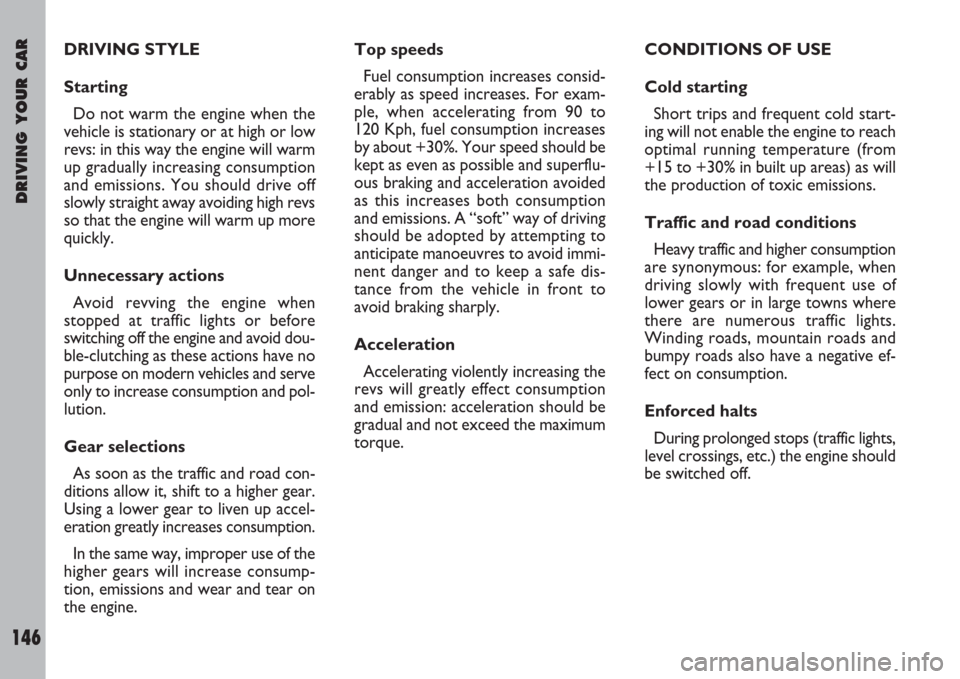
DRIVING YOUR CAR
146
DRIVING STYLE
Starting
Do not warm the engine when the
vehicle is stationary or at high or low
revs: in this way the engine will warm
up gradually increasing consumption
and emissions. You should drive off
slowly straight away avoiding high revs
so that the engine will warm up more
quickly.
Unnecessary actions
Avoid revving the engine when
stopped at traffic lights or before
switching off the engine and avoid dou-
ble-clutching as these actions have no
purpose on modern vehicles and serve
only to increase consumption and pol-
lution.
Gear selections
As soon as the traffic and road con-
ditions allow it, shift to a higher gear.
Using a lower gear to liven up accel-
eration greatly increases consumption.
In the same way, improper use of the
higher gears will increase consump-
tion, emissions and wear and tear on
the engine.Top speeds
Fuel consumption increases consid-
erably as speed increases. For exam-
ple, when accelerating from 90 to
120 Kph, fuel consumption increases
by about +30%. Your speed should be
kept as even as possible and superflu-
ous braking and acceleration avoided
as this increases both consumption
and emissions. A “soft” way of driving
should be adopted by attempting to
anticipate manoeuvres to avoid immi-
nent danger and to keep a safe dis-
tance from the vehicle in front to
avoid braking sharply.
Acceleration
Accelerating violently increasing the
revs will greatly effect consumption
and emission: acceleration should be
gradual and not exceed the maximum
torque.CONDITIONS OF USE
Cold starting
Short trips and frequent cold start-
ing will not enable the engine to reach
optimal running temperature (from
+15 to +30% in built up areas) as will
the production of toxic emissions.
Traffic and road conditions
Heavy traffic and higher consumption
are synonymous: for example, when
driving slowly with frequent use of
lower gears or in large towns where
there are numerous traffic lights.
Winding roads, mountain roads and
bumpy roads also have a negative ef-
fect on consumption.
Enforced halts
During prolonged stops (traffic lights,
level crossings, etc.) the engine should
be switched off.
Page 148 of 254
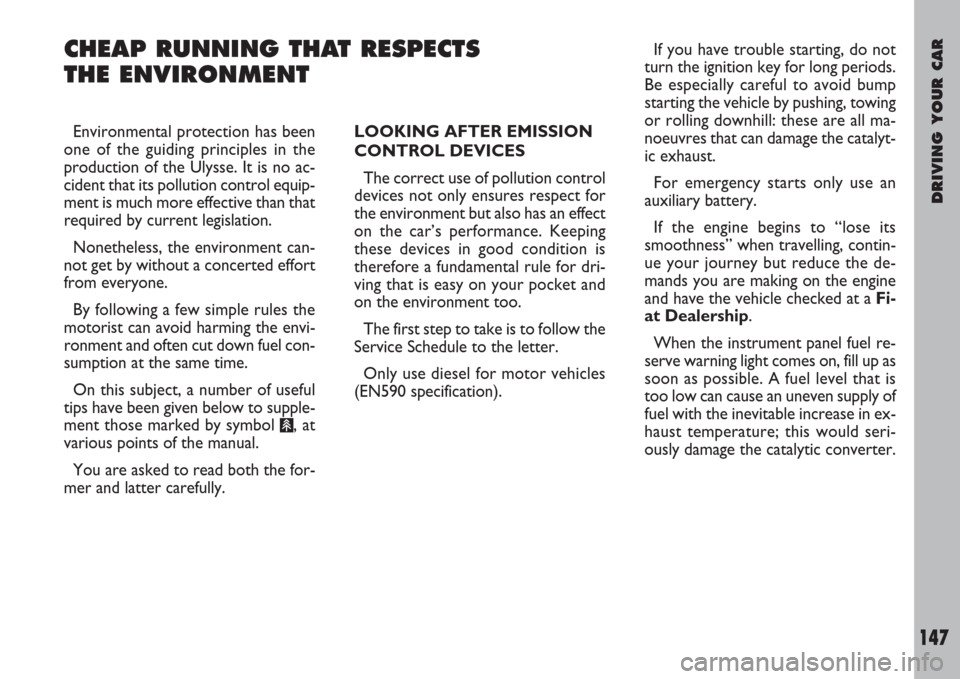
DRIVING YOUR CAR
147
CHEAP RUNNING THAT RESPECTS
THE ENVIRONMENT
LOOKING AFTER EMISSION
CONTROL DEVICES
The correct use of pollution control
devices not only ensures respect for
the environment but also has an effect
on the car’s performance. Keeping
these devices in good condition is
therefore a fundamental rule for dri-
ving that is easy on your pocket and
on the environment too.
The first step to take is to follow the
Service Schedule to the letter.
Only use diesel for motor vehicles
(EN590 specification). Environmental protection has been
one of the guiding principles in the
production of the Ulysse. It is no ac-
cident that its pollution control equip-
ment is much more effective than that
required by current legislation.
Nonetheless, the environment can-
not get by without a concerted effort
from everyone.
By following a few simple rules the
motorist can avoid harming the envi-
ronment and often cut down fuel con-
sumption at the same time.
On this subject, a number of useful
tips have been given below to supple-
ment those marked by symbol
#, at
various points of the manual.
You are asked to read both the for-
mer and latter carefully.If you have trouble starting, do not
turn the ignition key for long periods.
Be especially careful to avoid bump
starting the vehicle by pushing, towing
or rolling downhill: these are all ma-
noeuvres that can damage the catalyt-
ic exhaust.
For emergency starts only use an
auxiliary battery.
If the engine begins to “lose its
smoothness” when travelling, contin-
ue your journey but reduce the de-
mands you are making on the engine
and have the vehicle checked at a Fi-
at Dealership.
When the instrument panel fuel re-
serve warning light comes on, fill up as
soon as possible. A fuel level that is
too low can cause an uneven supply of
fuel with the inevitable increase in ex-
haust temperature; this would seri-
ously damage the catalytic converter.
Page 149 of 254

DRIVING YOUR CAR
148
Do not warm up the engine by let-
ting it idle for a while before moving
off unless the outside temperature is
very low and, even in this case, only
do so for less than thirty seconds.
Do not install other heat shields and
do not remove those already fitted to
the catalytic converter and exhaust
pipe.Do not spray anything
on the Lambda sensor
and exhaust pipe.TOWING A TRAILER
IMPORTANT
The car must be fitted with a ho-
mologated tow hitch and suitable elec-
trical system for towing a caravan or
trailer.
To prevent damages to the electric
system of the car, it is recommended
to install a dedicated trailer electron-
ic control unit.
Have the tow hitch fitted by an ex-
pert who will issue specific documen-
tation for use on roads.
Fit special and/or additional rearview
mirrors in accordance with the High-
way Code.
Remember that towing a trailer
makes it harder for the car to climb
the maximum gradients specified, in-
creases braking and overtaking dis-
tance, proportionally to the overall
weight of the trailer.
Engage a low gear when driving down-
hill rather than constantly braking. When functioning nor-
mally the catalytic con-
verter develops high tem-
peratures. For this reason, do not
park the vehicle over inflamma-
ble material (grass, dry leaves,
pine needles, etc.): fire hazard.Failure to heed these
precautions could cause a
fire.
Page 150 of 254
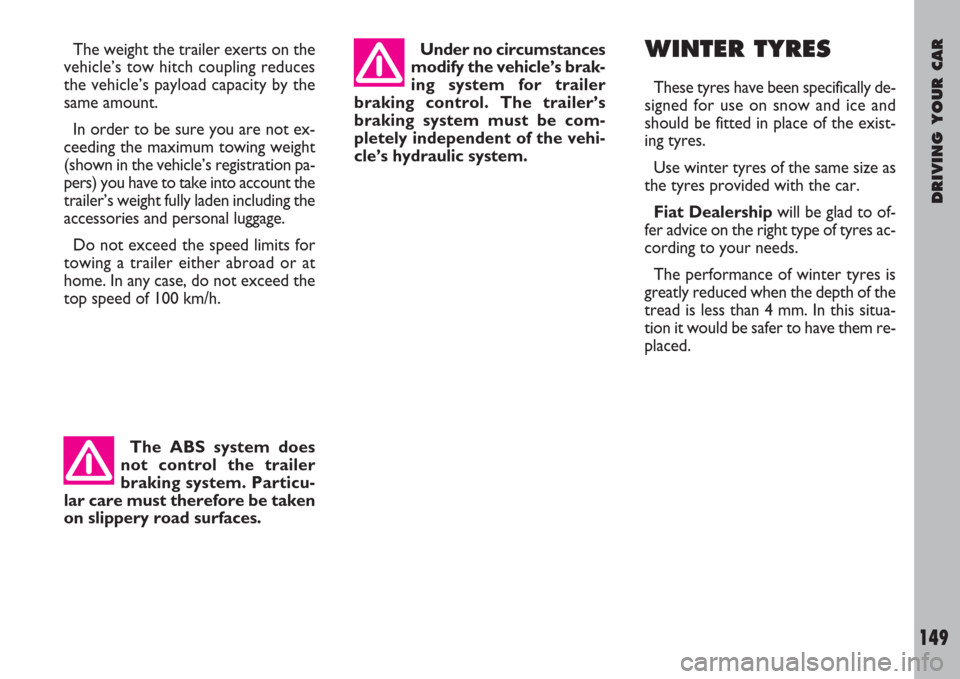
DRIVING YOUR CAR
149
The weight the trailer exerts on the
vehicle’s tow hitch coupling reduces
the vehicle’s payload capacity by the
same amount.
In order to be sure you are not ex-
ceeding the maximum towing weight
(shown in the vehicle’s registration pa-
pers) you have to take into account the
trailer’s weight fully laden including the
accessories and personal luggage.
Do not exceed the speed limits for
towing a trailer either abroad or at
home. In any case, do not exceed the
top speed of 100 km/h.WINTER TYRES
These tyres have been specifically de-
signed for use on snow and ice and
should be fitted in place of the exist-
ing tyres.
Use winter tyres of the same size as
the tyres provided with the car.
Fiat Dealershipwill be glad to of-
fer advice on the right type of tyres ac-
cording to your needs.
The performance of winter tyres is
greatly reduced when the depth of the
tread is less than 4 mm. In this situa-
tion it would be safer to have them re-
placed.
The ABS system does
not control the trailer
braking system. Particu-
lar care must therefore be taken
on slippery road surfaces.Under no circumstances
modify the vehicle’s brak-
ing system for trailer
braking control. The trailer’s
braking system must be com-
pletely independent of the vehi-
cle’s hydraulic system.